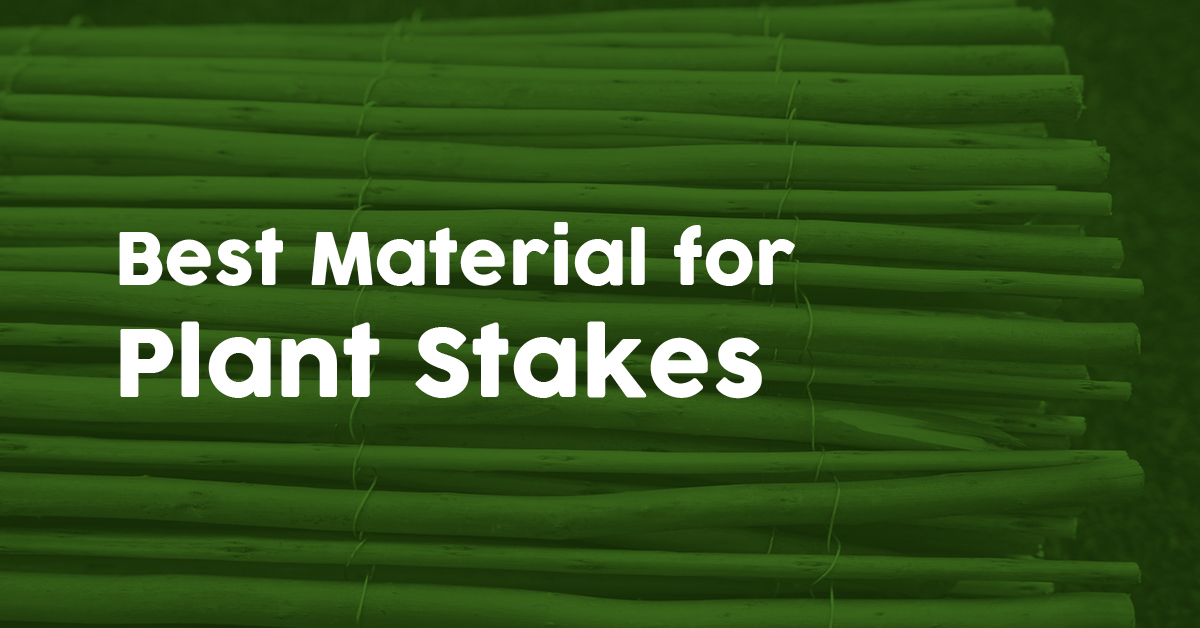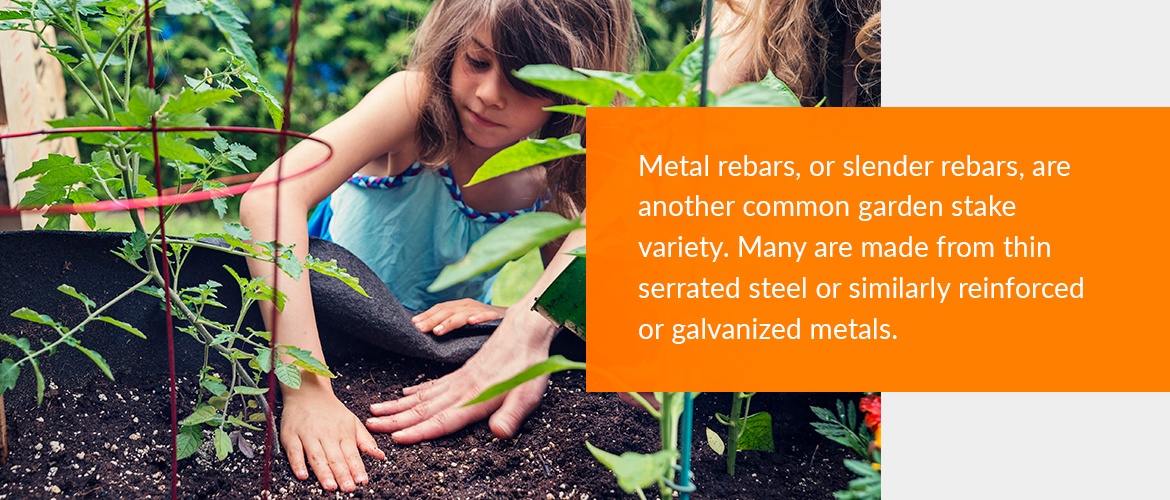
Wood, plastic, bamboo — oh my! Who knew picking the right stakes for healthy plant growth could be so complicated?
With gardening season just around the corner, it’s crucial to select the best plant stakes for your flowers, herbs, fruits and veggies — one that’ll help your garden thrive and bring other benefits to your backyard.
Jump To Sections:
What Are Plant Stakes For?
Plant stakes provide essential support for flowering perennials and produce expected to grow over a few feet tall or those with heavy, bulbous flowers.
Without a sturdy vertical post to cling to, the stems on these tall plants are susceptible to snapping, both during inclement weather and across its regular growth stages.
Plant stakes can be used alongside other plant-support structures added to your garden, including:
- Trellises
- Arbors
- Mesh cages or chicken wire
- Natural fencing
- Hoops
- Half-walls
- Plant cages
Each provides a decorative touch and a functional addition to your backyard. However, dedicated plant stakes still offer the best spot support for plants as a whole. Individual stakes will help nurture optimal vertical plant growth, spacing and overall garden shaping, making them an ideal choice when prepping your garden.
To stake, use twine or string to loosely entwine your selected plant’s stem to its adjacent stake. Ensure you’re entwining a majority of the plant’s stem to its stake for proper, long-term strength and support.
Common garden plants that require staking for optimal growth include the following:
- Tomatoes
- Cucumbers
- Sweet peas
- Bell peppers
- Melons
- Pumpkins
- Squash
- Raspberries
- Blackberries
- Dahlias
- Delphiniums
- Peonies
- Hibiscus
- Lillies
- Zinnias

What Are Common Plant Stake Materials?
There are several materials that solo-plant stakes are made from. The most common staking materials today include:
- Wood or wood composite
- Plastic
- Metal rebar
- Bamboo
While planning your upcoming garden, consider the pros and cons of each material, noting how each will work with your chosen garden plantings, area climate, garden size and preferences.
Comparing Wood, Plastic, Metal and Bamboo Plant Stakes
Use the following guide as a resource when determining the best plant stake for your garden.
1. Wood and Wood Composite Stakes
Wood and wood composition plant stakes are a common type used by gardeners.
Pure wood stakes can come in split or spawn cuts and are fashioned from organic materials, preserving the natural look and ambiance of your garden. Nearly any kind of wood can form the material base for outdoor garden stakes.
Here are some of the advantages and disadvantages of wood and wood composite stakes:
- Advantages: Wood and wood composite stakes are lightweight yet durable for single-season usage. Adding wood stakes to your garden beds is a natural-appearing and fairly unobtrusive staking option. Raw, unfinished and untreated stakes won’t expose your soil beds to unwanted chemicals or byproducts.
- Disadvantages: Wood stakes are susceptible to cracks and breakage themselves, especially during initial installation when digging into your dirt beds. Wood stakes may also warp in sunlight, particularly if stakes are two-inches or thinner. Wood stakes will also generally need to be removed at the end of the gardening season. Some varieties may last two or more seasons but will require diligent care, especially if you use a mallet to pound stakes into your garden beds.
2. Plastic Stakes
Plastic-based garden stakes are another common choice when supporting garden perennials and produce-bearing plants.
While inexpensive and widely available, gardeners should be vigilant about the exact composition of their chosen plastic-based stakes. Some states assist consumers by requiring labels warning against using plastics in certain applications. Take care to check municipal environmental statutes or resources before driving any plastic-based garden products into your yard.
Here are some of the advantages and disadvantages of plastic stakes:
- Advantages: Plastic stakes are common and easily available online or at local hardware stores. They are a budget-friendly and reusable form of garden staking.
- Disadvantages: Some plastic garden-stake varieties carry the concern of chemicals and toxins leaching into soil beds. Some municipalities may even prohibit the use of certain plastic products in outdoor environments, including residential gardens.
3. Metal Rebars
Metal rebars, or slender rebars, are another common garden stake variety.
Many are made from thin serrated steel or similarly reinforced or galvanized metals. Compact metal rebar varieties are also available, though plants may outgrow these by the end of the season and must be monitored closely.
Here are some of the advantages and disadvantages of metal stakes:
- Advantages: Metal stakes anchor well, providing a robust and immobile scaffold for plant growth. Metal stakes drive and wedge easier into dirt beds than wood-based stakes, making them simpler to install and position while also withstanding inclement weather. Metal-based stakes are also extremely durable and can last for several seasons, depending on the quality of the galvanized metal and the care taken when inserting them in and out of the ground.
- Disadvantages: Metal rebars can add an industrialized look to your garden before plant foliage grows, particularly if you require many of them. The cost-per-stake or cost-per-bundle will also be higher than other types of garden stakes.

4. Bamboo Stakes
Lastly, bamboo stakes are another popular pole type to ground and support your garden plants.
Bamboo is perhaps most lauded as an eco-friendly natural material used in fabricated products and building construction, so long as it has not been chemically treated. This is largely due to how fast bamboo grows — making it a quickly replenished crop — as well as its ability to adapt to a surprising range of climates and conditions.
However, there are several additional benefits of bamboo plant stakes, including:
- Advantages: Bamboo plant stakes are an increasingly popular option because they are eco-friendly and easy to use. This versatile and long-lasting alternative will keep your plants upright and your garden looking polished. At Forever Bamboo our stakes are sourced from high-quality bamboo and dried in kilns to minimize cracking, mildew and mold. Using bamboo plant stakes maintains that effortlessly organic appearance of your growing garden before and after foliage sprouts. They are available in various natural-looking shades of beige, yellow and tan.
- Disadvantages: Like wood and wood composite stakes, most bamboo-based plant stakes will need to be replaced at the end of the gardening season.
What Is the Best Plant Stake for Plant Growth?
We recommend bamboo plant stakes for most residential gardens. A bamboo-based stake provides a range of advantages compared to other staking materials, including:
- Cost-conscious
- Widely available
- Eco-friendly
- Naturally anti-fungal and anti-bacterial
- Minimal invasive pest risk
- Sturdy and supportive
- Aesthetically attractive in your garden
Shop today and put our premium bamboo stakes to the test this gardening season!
